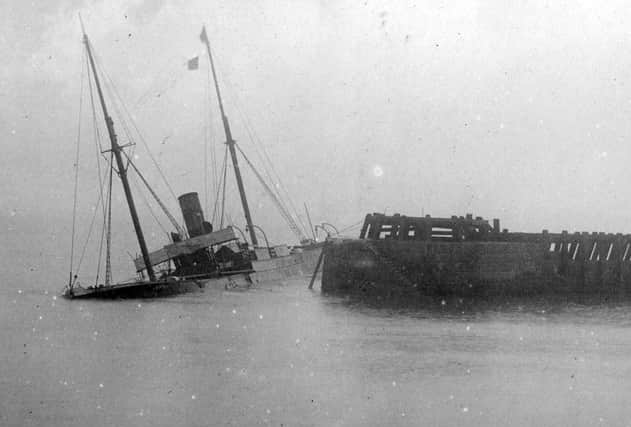ON THE WATERFRONT: A series of shipping calamities


On the morning of January 29, the 1,068 gross-ton Londonderry collier Linden approached the South Outlet in ballast from London for South Docks, while the 97 gross-ton Irwing steam paddle tug General Gordon waited to tow her into the docks.
As the vessels passed through the breakwaters, rough seas struck the collier, causing the tugboat’s line to part and Linden to drift onto South-West Breakwater end with great force, resulting in extensive damage to her bows.As the tide ebbed, the leaking ship became stranded on rocks and filled with water, receiving further damage on the next flood tide.
Advertisement
Hide AdAdvertisement
Hide AdWorkmen stripped all moveable equipment from the ship, which was dynamited in an effort to clear the wreckage. Unfortunately, she later broke in two with her bow section being washed into the centre of the channel.
It would not be until mid-February that the bow part was successfully raised, with her engines being recovered on April 26.
Proof of the wreck causing a hazard to navigation came late on February 6, when the 1,288 gross-ton JS Barwick steamer Saltburn struck Linden’s wreckage while outward bound for Rochefort with coal, causing a considerable gash in her hull plates.
Once in the open sea, Saltburn began to leak badly and made a dash for the main harbour. On her approach, however, she went down by the head and grounded near the entrance. Later, she became almost completely submerged before efforts could be made to patch the hole and pump her out.
Advertisement
Hide AdAdvertisement
Hide AdMatters became worse early on January 29, when the 1,047 gross-ton German steamship Pinnas, owned by JH Lorentzen and Co, rammed into Saltburn, despite a guard tug (General Gordon) being present. With Pinnas damaged below the waterline, the tug made fast and towed her towards harbour, where she sank on the bar.
On February 11, both Saltburn and Pinnas were refloated.
Saltburn was raised by salvor Thomas Metcalf, being towed to the dock basin entrance by the tugs Ben Ledi, Rescue, Norfolk Hero, General Gordon, Electric and Silksworth. Afterwards, she entered No 2 Graving Dock for repairs, subsequently being returned to service.
Pinnas was raised by Stand Slipway Company, with the River Wear Watch fire steamer Fire Queen being engaged to pump her out. She was beached at Polka Hole before being taken to the dock basin entrance near Calder’s yard. After repairs, she also re-entered service.
By coincidence, all three ships been built by Short Brothers of Pallion; Linden in 1877, Saltburn in 1883 and Pinnas (as Silksworth) in 1874.